Vol 2 No. 25 TROPIC LIGHTNING NEWS June 26, 1967
Index
Operations Working For Better Life
1st Bde Hitting Hard,
Keep VC On The Move
From a new fire support base deep in the Boi Loi Woods, the
"Golden Dragons" initiated Operation "Barking Sands" in the middle of
May. From this and other bases, search and destroy operations are being
conducted in the local areas which were known to be heavily infested with Viet
Cong.
These areas provided sanctuary for the enemy because of the heavy
bush, marsh, and elephant grass. In addition, the enemy was well
entrenched with many tunnels and fortified bunkers.
Through the combined efforts of the 1st Bde line companies, 7th Bn,
11th Arty, 2nd Bn, 34th Armor, Air Force and local Vietnamese units, VC are
being harassed, demoralized, and rapidly losing ground.
The fighting has been exhausting and difficult. The enemy has
suffered severely. Recently 51 VC possible were reported as a result of
air strikes in support of an infantry assault. Several ambushes have
netted VC tax collecting patrols. Enemy lines of communication have been
broken because of the constant daytime clearing missions.
Many MEDCAPs have been conducted to aid the villagers, and gain
first hand intelligence information. Much ammunition has been captured as
well as Russian assault rifles and Chinese Communist anti-tank weapons.
Three heavily armed sampans were sunk.
The fight has forced the Viet Cong to be constantly on the move
with no rest. This has resulted in freeing the people from the grasp of
the VC.
2nd Bde Holds Large County Fair
The 2nd Bde Civil Affairs section and the 1st Bn (Mech), 5th Inf
recently processed more than 800 Vietnamese civilians through a "County
Fair" operation in a single village seal and search. Brigade officers
called it the largest and most elaborate operation of its kind in the division
this year.
The event, held at Ap Tho Mo southwest of the Cu Chi base camp, was
highlighted by an inspection visit by the National Defense Minister of Vietnam,
GEN Cao Van Vien.
Before dawn, elements of the mechanized battalion sealed off the
hamlet with their armored personnel carriers and Co C swept through the area.
They moved civilians to the processing site in a broad field outside the hamlet.
Eight separate stations made up the "County Fair" operation.
They included census and interrogation, two information posts, animal husbandry,
agriculture, a cultural team, a medical care station, and food and clothing
distribution points.
Loudspeaker broadcasts by an ARVN team before and during the
"County Fair" explained the operations and told of the benefits of the newly
completed Duc Hoa-Bao Trai road. Built by the 2nd Bde and 65th Engr Bn.,
it is the area's first high speed route connecting the two villages.
More than 200 medical patients were treated at the care station
manned by brigade and battalion surgeons.
Nine hundred pounds of food, clothing and reading material were
distributed along with 130 special eating utensil sets.
Representatives of the Vietnamese district included the district
chief, assistant chief, and chief of police.
The elaborate operation was part of the Brigade Operation
"Kolekole" that is combining combat with Revolutionary Development goals in
the Hau Nghia Province area.
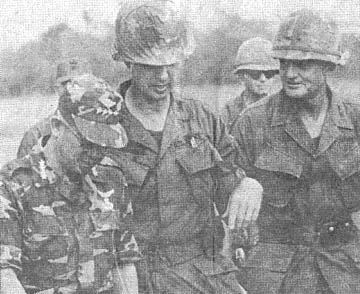 |
LTC Ted Gordinier (center), acting commander of the 2nd Bde explains one of the eight stations in the extensive "County Fair" program to GEN Cao Van Vien, Vietnamese National Defense minister and MG John C. F. Tillson III, commander of the 25th Inf. Div. (Photo by 1LT A R Karel) |
4 Objectives For Monsoon 'Kolekole'
Operation "Kolekole," being conducted by the 25th Inf Div 2nd
Bde is far more than a combat operation. The unit has four ambitious
objectives that will mean a better, more secure life for the Vietnamese people
of Hau Nghia Province.
Kolekole is part of the "Tropic Lightning" monsoon campaign
designed to beat the Viet Cong in the very season that has most favored them in
the past.
"Our primary objective is, of course, to destroy Viet Cong forces
and organization in the entire area," explained COL Marvin D. Fuller, brigade
commander. "But we also want to make sure that when Kolekole is over the
progress made won't be lost."
The most immediately visible phase of the unit's plan is a major
upgrading of the road system. Most Hau Nghia roads had been mined,
cratered and trenched by the Viet Cong. Already, the main link between Duc
Hoa and Bao Trai, two major villages, is complete.
The work, being done by the 65th Engr Bn, is making overland travel
between villages possible again. Not only will ARVN forces be able to move
swiftly throughout the province, but civilians will now be able to move local
products to new markets.
As a third objective, the brigade is assisting Vietnamese forces.
"Buddy operations" give these units all-important experience in joint combat
operations. In addition, combat outposts of Vietnamese militia units are
being strengthened.
Hoi Chanh Proof 'Arms' Program Is for Tomahawks
The Chieu Hoi program is proving its worth to the 4th Bn (Mech),
23rd Inf, 25th Inf Div.
While acting on a tip from a Hoi Chanh, the "Tomahawks" entered
the Bee Don area and immediately discovered newly constructed huts.
After careful inspection of the "find," a large hut was found
filled with a total of 18,900 lbs of bagged polished rice. An additional
5500 lbs of loose rice were found. This was one of the largest caches
found by the Mech outfit in recent months.
Previously two Hoi Chanh, found near Ben Go during a buddy
operation, turned over information leading to the discovery of a Viet Cong base
camp.
With the combined forces of the Tomahawks and 4th Bn, 9th Inf, the
area was thoroughly searched, which resulted in the discovery of a cement tunnel
complex and small arms cache.
Evidence showed that the VC had fled their "haven" shortly
before the arrival of the 25th infantrymen.
Additional information given by the Hoi Chanh showed that the VC
feared the powerful air strikes and the artillery of the American forces.
Ivymen On 'Diamondhead' Sweeping in War Zone C
DAU TIENG - One Viet Cong was killed by Co A, 2nd Bn
(Mech), 22nd Inf, when a platoon size patrol moved up and surrounded some
hootches. The
action took place on Operation "Diamond Head" in War Zone C.
The patrol, led by 2LT Gregory James from Greer, S.C., was sweeping
northeast of Tay Ninh city in War Zone C when they came upon a well used trail.
The scout dog immediately alerted and indicated that something was a little
further up the trail.
With SSG Arthur W. Way of Columbus, Ga., handling the dog,
"Rinnie" led the men as they swept in the direction that the trail led.
When the dog again alerted he was sent to the rear and the patrol
prepared for action. After going a few more yards some digging sounds were
heard by the lead elements. At this time James deployed his men by moving
them forward on the flanks while he crept up along the trail. The object
was to surround the people who were making the noises.
But, as usual, things don't always go as planned. Just at
this time, a Viet Cong chose to stop digging and walk across the trail to where
his food, water, and weapon were hanging on a tree.
"When I saw that the Cong was going to see my point man,
who was crawling forward near the trail," said James, "I shouted to charge
the hootch and then aimed and shot."
The patrol charged the area just in time to see another VC hightail
it out the back door, leaving his weapon and personal gear.
The results were one Viet Cong killed, two weapons, clothes and
documents captured, and a hootch and partially dug bomb shelter destroyed.
If at First You ...
Then Give Up!
The 65th Combat Engr Bn had constructed a footbridge across the
Saigon River, 32 kms north of Cu Chi.
About 3 a.m. the security force heard a sampan coming up river.
The people in the sampan apparently couldn't see too well. "Crunch"
went the sampan as it hit the bridge. After considerable chatter the
sampan backed off and tried again some 20 meters to the right. "Crunch."
Again the chatter and another attempt, about 40 meters to the left.
"Crunch." Apparently convinced that whatever was blocking the river
was too wide to get around, the sampan and its unknown occupants went back.
And as they say around here, "Sorry 'bout that."
VC Murder 3 Civilians
DAU TIENG - The bodies of three Vietnamese, two men and one woman,
were found recently by the 3rd Bde, 4th Inf Div. The throat of each victim
had been slashed by Viet Cong.
Second Lieutenant Michael D. DeCamp from Cincinnati, Ohio, was
leading a platoon of the 2nd Bn (Mech), 22nd Inf, on a search and clear mission
when they discovered three dirt mounds similar to numerous ammunition and
weapons caches found recently in the area. The men dug into the mounds.
They found not weapons, but the bodies of three civilians who had
recently been buried.
Cacti Men Kill Thirty NVA
DUC PHO - The sudden flash and sharp crack of enemy mortar
explosions shattered the silence. The incoming rounds signalled the
beginning of a three-hour night battle which many men of the Recon Plt and Co B
of the 2nd Bn, 35th Inf, will long remember.
The "Cacti" had been sweeping an area where there had been
recent clashes with units of an NVA battalion. It was late afternoon when
the infantrymen set up their perimeter for the night. Ambushes were set
along enemy routes.
At 2:30 the first mortar rounds landed and contact was made for the
third time in three days. The NVA hit the Cacti with everything they had. It
was estimated 100 to 150 rounds of 60mm and 82mm mortar and recoilless rifle
were fired at the infantrymen. The enemy then assaulted, supported by two
machine guns, attempting to penetrate the perimeter.
Artillery immediately began to pound the charging enemy and was
lifted only long enough for the gunships and "Spooky" to have their chance.
"My platoon was on ambush when the first rounds landed," said
2LT Walter Twyford. "We moved back to the perimeter as fast as we could.
The men on the perimeter were running low on ammo when we arrived after slicing
through the enemy on the way in."
The recon platoon, also on ambush, moved back to reinforce the
perimeter.
Dug in behind rice paddy dikes, the Cacti fought to hold off the
furious assault by the NVA unit. The enemy charge carried them close
enough to throw grenades over the paddy dikes. Gunships from the 1st of
the 9th Air Cav with flawless accuracy delivered their ordnance within 20 meters
of the infantrymen driving back the enemy assault.
With the enemy momentum broken the Cacti swept the enemy back.
Daybreak revealed a battlefield littered with bodies of NVA.
A total of 30 NVA were killed and three captured. Sixteen weapons were
captured including a 57mm recoilless rifle and three light machine guns.
Page 2 TROPIC LIGHTNING NEWS June 26, 1967
Decorated
| SILVER STAR | |
|
MAJ Gene P. Hill, HHC, 1st Bn (Mech), 5th Inf CPT William T. Dineno, Hq & Svc Btry, 2nd Bn, 77th Arty CPT Elmo D. Ozment Jr., 3rd Bn, 22nd Inf |
SFC Alexander C. Willis, Btry C, 2nd Bn, 77th Arty SGT Joe D. Shields, Co B, 3rd Bn, 22nd Inf PFC Francis H. Good, Co B, 3rd Bn, 22nd Inf |
| BRONZE STAR (VALOR) |
|
|
CPT Leonard G. Marcum, Co A, 1st Bn, 27th Inf 1LT Stephen H. Ehart, Co A, 2nd Bn, 27th Inf 1LT James D. Goolsby, Btry C, 2nd Bn, 77th Arty 1LT John M. Meade Jr., Btry A, 2nd Bn, 77th Arty 2LT Rodney Erakovich, Co B, 2nd Bn., 12th Inf 2LT Holger N. Graser, HHC, 3rd Bn, 22nd Inf 2LT Harvey L. Haxton, Co B, 2nd Bn, 12th Inf 1SG Andrew J. Desmond, HHC, 2nd Bn, 34th Armor SSG Robert C. Beaty, HHC, 23rd Bn, 22nd Inf SSG Franklin G. Galbraith, HHC, 2nd Bn (Mech), 22nd Inf SSG Clifton E. Gosser, Trp A, 3rd Sqdn, 4th Cav SSG Herbert Headley, Trp B, 3rd Sqdn, 4th Cav SSG Willie R. Hood, Co B, 3rd Bn, 22nd Inf SSG John O. Lampkin, HHC, 3rd Bn, 22nd Inf SSG Lothar W. Schmidt, Btry A, 2nd Bn, 77th Arty SGT Sherman F. Goldsberry,, Btry A, 2nd Bn, 77th Arty SGT Benjamin M. Jones Jr., HH&S Btry, 2nd Bn, 77th Arty SGT Felix Moreno, Trp A, 3rd Sqdn, 4th Cav SGT Thomas J. Pepe, Btry A, 2nd Bn, 77th Arty SGT Forest A. Pitre, Btry C, 2nd Bn, 77th Arty SGT Audia G. Ruiz, Co C, 2nd'Bn, 12th Inf SGT Gary L. Scott, Co A, 3rd Bn, 22nd Inf CPL Richard J. Special, Btry B, 2nd Bn, 77th Arty |
SP4 Franklin J. Adams, Btry B, 2nd Bn, 77th Arty SP4 Arthur Alamaquer, HHC, 3rd Bn, 22nd Inf SP4 William F. Benefield, HHC, 1st Bn, 27th Inf SP4 William H. Gray, Btry B, 2nd Bn, 77th Arty SP4 James M. Hall, Btry C, 2nd Bn, 77th Arty SP4 Frederick A. Hlavas, Btry B, 2nd Bn, 77th Arty SP4 Theodore H. Larsen, Btry A, 2nd Bn, 77th Arty SP4 Ernest R. Lopez, Co A, 2nd Bn, 27th Inf SP4 James R. Morales, Btry B, 2nd Bn, 77th Arty SP4 Harry J. Nagele, Co B, 3rd Bn, 22nd Inf SP4 Pete J. Negrete, Btry C, 2nd Bn, 77th Arty SP4 Henry S. Poskey, HQ & Svc Btry, 2nd Bn, 77th Arty SP4 Manuel Rubio Jr., Btry C, 77th Arty SP4 Perry Snyder Jr., Btry C, 2nd Bn, 77th Arty SP4 Duane C. Stormer, HHC, 3rd Bn, 22nd Inf SP4 Edwin Walker, Co A, 4th Bn, 9th Inf SP4 Willie L. Williams, Hq & Svc Btry, 2nd Bn, 77th Arty PFC Billy G. Funk, Co C, 4th Bn (Mech), 23rd Inf PFC Isaac Goodman, Btry A, 2nd Bn, 77th Arty PFC Michael J. Janetski, Co B, 1st Bn (Mech), 5th Inf PFC Richard T. Linnemann, Co B, 3rd Bn, 22nd Inf PFC Gary L. Roberson, HHC, 3rd Bn, 22nd Inf PFC Richard Ward, Co B, 3rd Bn, 22nd Inf |
Problem? See Your CO
"I'm going to see the Inspector General!"
You have probably heard this declaration not once, but many times
in the course of your Army career. You may have even made this statement
yourself. But what does the statement mean to you? What is an
Inspector General? What role does he play in your life and in the United
States Army? When should you take your problems to the Inspector General,
and when should you take them to your unit commander?
Let us take these questions one at a time, look at the answers, and
see if we can obtain a good general understanding of the role of the Inspector
General and the complaint and redress system available to each person in the
United States Army.
Your division Inspector General conducts at least one full Annual
General Inspection of each company size unit, headquarters, and activity within
the division during the fiscal year.
A team of qualified inspectors evaluates the unit's mission
performance and state of discipline, efficiency and economy and a report of its
findings is provided to the commanding general so that he may evaluate the
condition of individual units of his command and the entire division.
Now let us deal with the question of which problems or complaints
should normally be presented to your commanding officer and which should be
presented to the Inspector General. Before we attempt to resolve this question,
let us consider some facts.
Each member of the formed services has a right to register
complaints, either orally or in writing, with the inspector general at least
quarterly.
Service personnel are encouraged to discuss their problems or
complaints FIRST with their unit commander; however, persons desiring to submit
a complaint will not be required to submit to an interview by anyone prior to
registering that complaint with an inspector general.
An inspector general may receive and process anonymous complaints;
however, the complainant cannot be notified of the results of the Inspector
General's actions.
Inspectors general are available to members of the services to
assist them in the resolution of personal problems. These actions are
referred to as "Request for Assistance", "Request for Advice", or
"Request for Information", and are not considered to be complaints.
Now that we have looked at some of the facts, we can better
determine to whom we should present problems or complaints.
The First Stop - Your CO
Your unit commander, like every other commander of every unit of
the United States Army, is charged with the responsibility of seeing to the
welfare, training, and employment of all personnel in his command. He is
vitally concerned with insuring that his unit accomplishes all assigned
missions, and he recognizes that his unit's mission can only be accomplished
through dedicated and devoted service of every individual in the unit. He
knows that individuals with personal problems or grievances cannot and do not
contribute their full share to the unit effort and that to resolve these
problems and grievances is to improve his unit and its overall efficiency.
This brings us then to the first and most important step in the Army Complaint
System.
Present all complaints and grievances to your unit
commander first. Give him a chance to solve your problem. It will
give you a better appreciation of what he can and will do for you and will help
him to know you better. In most cases, matters referred to the Inspector
General usually end up right back in the hands of the unit commander anyway.
He is the one person who can normally correct conditions or circumstances which
contributed to the situation which caused your problem in the first place.
If, after presenting your problems to your unit commander, you do
not consider his actions to be adequate, then you can and should present your
problem to the Inspector General and request his assistance. If you feel
that your problem is so sensitive that you do not want the unit commander to
know about it then, of course, you may present your problem directly to the
Inspector General for consideration. The Inspector General will inquire
into the matter, and provide you with an appropriate reply about those matters
which affect you personally.
Channels and the Chain of Command
Currently there is a problem vital to the interests of every member
of the United States Army. Some personnel do not take advantage of the
command and Inspector General channels available to them. Instead, they
present grievances and complaints directly to members of Congress and to the
President of the United States. These actions result in a serious drain on
the time and effort of persons charged with the tremendous burden of directing
the government.
Do you know what happens to these grievances and complaints - you
guessed it - they end up back on the desk of your unit commander for resolution
and the end result is the same as it would have been had you presented your
problem to him in the first place. Except for one thing; there is a
tremendous administrative burden which accompanies each complaint sent down from
Congress or other higher authority. Wouldn't it be simpler, faster, and
a lot less trouble for everyone if you presented your complaint to your unit
commander in the first place. When you bypass the commander and the
Inspector General, you delay the solution of your problems and cause unnecessary
paperwork as. well.
Under our democratic system of government you have the undeniable
right and privilege to communicate directly with any member of our government.
However, you will find that your problems can normally be solved more quickly
and easily and with a great deal more efficiency if presented FIRST to your unit
commander and SECOND to your local Inspector General if you are not satisfied
with the results obtained by your unit commander.
The 25th Inf Div Inspector General is available to personnel of the
division at all times. If you are at a field location or at Cu Chi camp
and want to see the Inspector 'General but have no way of getting to the
Inspector General's office, you have the following recourse:
Contact the Inspector General at CU CHI 107.
Send a letter or message to the Inspector General, 25th Inf Div
(Local), APO 96225.
Ask your ISG or unit commander or fellow soldier to request that
the Inspector General visit you in the field or at Cu Chi camp.
Do not go AWOL to visit the Inspector General.
Headquarters, 25th Inf Div Regulation 20-5 dated 9 April 1966 is
permanently posted on your bulletin board and should be referred to for
Inspector General visits.
Airlines Offer 'Wife' Rates For Hawaii Bound
MACV (SAIGON) - The Military Airlift Command has announced that
wives of military personnel planning to visit their husbands in Hawaii during
R&R may take advantage of new reduced airfares effective June 24.
The discount of approximately 25 per cent is on a economy (tourist)
class tickets from the west coast to Hawaii. Flights will depart from
Seattle-Tacoma, San Francisco and Los Angeles. Airlines offering the
reduced fares are Pan American, United and Northwest.
The reduced rates apply only to wives (not parents or dependent
children) of men in Vietnam; on round trip tickets which are good for only 15
days from time of departure until time of return. Reservations may
be obtained at any airline ticket office or JAMTO. Cost of the round-trip
ticket will be $165.00.
A MACV orders form similar to DD1580 will be overprinted on the
reverse side and must be used. It will be available to individuals through
component commands. The forms are authorized to be reproduced locally.
The TROPIC LIGHTNING NEWS is an authorized publication of the 25th Infantry Division. It is published weekly for all division units in the Republic of Vietnam by the Information Office, 25th Infantry Division, APO San Francisco 96225. Army News Features, Army Photo Features, Armed Forces Press Service and Armed Forces News Bureau material are used. Views and opinions expressed are not necessarily those of the Department of the Army. Printed in Tokyo, Japan, by Pacific Stars and Stripes.
MG John C. F. Tillson III . . . . . . . . Commanding General
MAJ Bernard S. Rhees . . . . . . . . . . Information Officer
CPT John P. Fortner . . . . . . . . . . . . Officer-in-Charge
SSG David G. Wilkinson . . . . . . . . Editor
SP4 Terry S. Richard . . . . . . . . . . . Editorial Assistant
SP4 John R. Dittmann . . . . . . . . . . Editorial Assistant
Page 3 TROPIC LIGHTNING NEWS June 26, 1967
Bobcats Get Mascot
The 1st Bn (Mech), 5th Inf has a new mascot at the Cu Chi base
camp, as Gatito, a full-blooded Mexican bobcat, took over with a growl.
He had just completed a trip half way around the world from El
Paso, Tex., to his new "assignment" with the 25th Inf Div unit.
Gatito was donated to the 2nd Bde unit by Roberto Cisneros of
Juarez, Mexico. Cisneros contributed the cat after he saw a story in a
local newspaper reporting that the battalion was looking for a mascot.
1SG Ignacio Medina of El Paso, a member of the mechanized unit,
wrote to the mayor of the city asking if the city could supply a mascot.
The local zoo superintendent suggested that the city was short of bobcats, but
had plenty of rattlesnakes. He offered to send one to Vietnam if the
battalion would change its nickname.
Before the idea could be sent to Vietnam, Cisneros volunteered
Gatito. The cat had been a pet for his three children. Cisneros said
that the children were sad to see the cat go, but that he was getting too big to
keep.
Two El Paso reporters traveled to Juarez to return the cat to El
Paso for shipment. An article in the paper the following day described the
major battle that occurred when the two tried to get Gatito into the traveling
cage.
After the trip to the El Paso zoo, where he received inoculations
and a medical checkup, the bobcat was caged in a special shipping box.
Employees of Pan American Airways sponsored his trip to Vietnam.
Twenty hours of jet flight brought Gatito to Saigon where 1LT Richard Ward, also
of El Paso and the executive officer of the unit's headquarters company, met
him.
"The label on the box read 'Live Bobcat,' but no one believed
it until they got next to it. Then they believed it," said Ward. "Every time we came near the crate, he hissed, growled and lunged. We
weren't too sure of the screening at the end of the box."
After a long growling trip, the soldiers arrived at Cu Chi where a
new cage in the battalion area awaited the new mascot. The fearless
soldiers opened the sliding door on the crate with a very long rope and Gatito
was home.
"We think he will be friendly after he quiets down from the
trip," said Ward, "but right now he's just getting used to Vietnam rain
and heat and he's pretty ferocious."
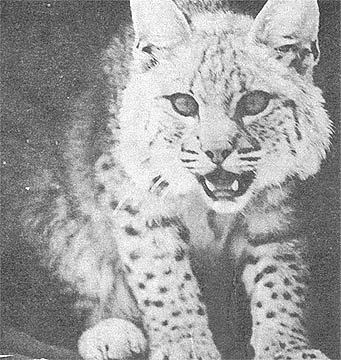 |
A BOBCATS' BOBCAT - Gatito is the new mascot of the 1st Bn (Mech), 5th Inf. |
Two Pilots Now 2nd Lieutenants
From a Mister to a Sir in two easy steps. Take off the WO
bars and pin on gold bars for a second lieutenant.
Two men of the 25th Avn Bn recently did this exchanging their WO
appointments for commissions.
Co A "Little Bear" 2LT Douglas L. Eckart and 2LT William C.
Bennett of Co B "Diamondheads" were the two pilots to pin on the gold bars.
Eckart, 23, joined the 25th last January and Bennett came to the
Tropic Lightning division last July. Bennett has the Air Medal with 16 Oak
Leaf Clusters.
The battalion' comnianoer, LTC William A. Beardon, gave the oath
to the two men.
Down Under
Australia To Become R&R Spot in Sept
Ed Note: The following item appeared in the Baltimore Sun and we
felt it might be helpful for those planning an R&R after Sept 1st.
The Australian tourist industry has begun preparations to handle a
"dollar invasion" by thousands of battle-weary United States servicemen
ready to go on the town with pockets full of dollars.
Under present plans, United States military authorities intend to
fly 12,000 troops a month from Vietnam starting Sept. 1 for rest and recreation
in Australia.
It is estimated the troops will boost the country's annual
tourist income by as much as 50 per cent and with a resounding roar the word has
gone out: "The Yanks are coming."
Military Team Visits
A United States military team visited Australia recently to inspect
amenities. Team members concentrated on Sydney, Australia's biggest city
with a population of more than 2,500,000, and Queensland's Gold Coast, the
nation's semi-tropical Florida-like playground.
Both offer sun-drenched beaches, ample sporting facilities and a
gay night life.
Ranges of Night Life
Staying in hotels and motels, they will find a night life which
ranges from exclusive restaurants, night clubs and discotheques to the shows of
Sydney's Bohemian Kings Cross Quarter.
During their inspection tour the United States Army team members
said that experience has shown that each GI spends between $150 and $300 during
a five-day "blow-out."
Samples Great at Ice Cream Plant
There are seven men working at the Cu Chi base camp that could
almost be considered "Good Humor Men." The men, headed by SSG Ronald
Watkins, are from the 25th S&T Bn and man the ice cream plant.
The plant was started in June 1966 and has put out more than 45,000
gallons of ice cream. All four two and a half gallon machines are put to work
each morning to produce the ice cream. It usually takes about nine minutes
to freeze a batch in the early hours of the day, but come afternoon the heat
raises the production time to around 30 minutes.
One good aspect of working in the plant is the sampling that takes
place. Naturally the ice cream has to be tasted to make sure it is coming
out right.
CPT Addicted To Grenades
DUC PHO - "I thought I'd had it when I saw him throw that
grenade!" exclaimed CPT Kenneth Barton, commander of Co B, 1st Bn, 35th Inf.
However, luck allowed Barton to walk away from the grenade
explosion with only a small cut above his eyes while his web gear was ripped to
shreds and his weapon smashed.
Bravo company, part of the 3rd Bde Task Force, 25th Inf Div. was on
a search and destroy mission northwest of Duc Pho when the patrol came under
heavy enemy fire.
As Barton maneuvered his company, one VC ran into a nearby bunker.
Before Barton could reach it, the VC ran out and threw a grenade near the trio
before being cut down. The explosion tore the captain's pistol belt in
half, ripped open his ammo pouch and canteens and smashed the hand guard of his
weapon.
PX Trailer Barber Shops Opened
Topnotch tonsorial technology tucked away into two trailers is the
timely topic of trimmed "Tropic Lightning" troopers.
This tongue-twister describes the two new barber shops put into
service this week by the Army and Air Force Exchange Service at the 25th Inf Div's
base camp in Cu Chi.
The five-chair barber shops are self-contained in air-conditioned
vans having all the latest equipment to be found in stateside shops.
Mirror-lined walls, electric clippers, hot water and upholstered chairs allow
"Tropic Lightning" division soldiers a brief break from the heat and jungles
in Vietnam. As one soldier was overheard saying, "Gosh, all this for 35
piastres?"
| SHAVE AND A HAIRCUT - Tropic Lightning soldiers enjoy the coolness of an air-conditioned trailer barber shop. One of the two new facilities is by the water point near the 2nd Bn, 14th Inf, and the other is beside the 65th Engrs. (Photo by SP5 Rodney Bryan) | 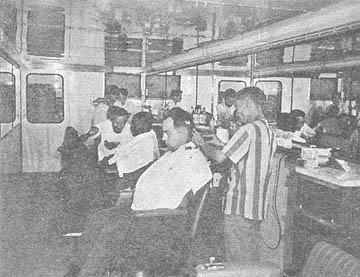 |
Page 4-5 TROPIC LIGHTNING NEWS June 26, 1967
'Dust Off' - A Race Against Death
It was 9:28 in the morning in the
"dust-off" bunker in the 25th Med Bn area when the radio blared "Dust-off
... Dust-off."
Three minutes later the chopper; with the red cross on the side,
lifted off the pad, dipped its nose, cut a hard left and headed for the pick up
spot. The pilot had been plotting the coordinates with the men in the
bunker while the crew fired up the "life saver."
Minutes later the pilot spiraled the ship sharply down to pick up a
wounded ARVN soldier. He had received grenade fragments in the lower
extremities and needed emergency treatment he couldn't receive in the field.
On the way to the 12th Evac Hosp the radio crackled as the call
came in concerning another dust-off near Tay Ninh.
The average number of dust-offs during daylight hours is five or
six for the Cu Chi facility. Night pickups vary from zero to 15 on a bad
night.
A crew chief supervises the ship with the pilot as the medic takes
care of the patient. Several litters are carried in the chopper along with
medical supplies and a hoist in case the craft can't land for the pickup.
Different units have the 25th Inf. Div beat. The unit
generally stays two days in Cu Chi working the area. A new team then comes
in and takes over for 48 hours.
"Dust-Off" has been credited with saving hundreds of lives by
speeding wounded men to hospital facilities. Many of these men would have
died, as they did in earlier wars, if it were not for these life saving machines
and their crews.
|
US ARMY PHOTOS |
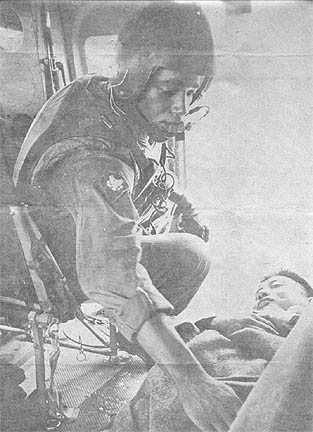 |
TAKE IT EASY SOLDIER - The airborne medic straightens the blanket and gives an encouraging word to the wounded ARVN soldier on the way to 12th Evac Hospital. |
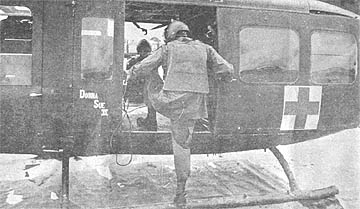 |
READY FOR LIFTOFF - The medic and the crew jump aboard the chopper to head for the pick up spot. Many times these missions are flown at night. |
| INTO THE LIFE SAVER - When the wounded man is loaded into the chopper the mission is half way over. | 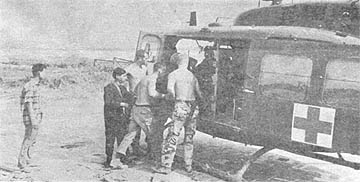 |
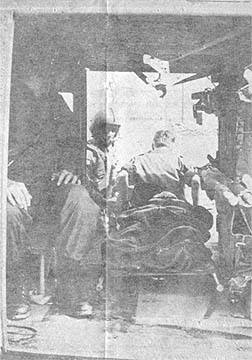 |
MEDICAL CARE IS STEPS AWAY - Medics from the Cu Chi hospital unload the patient. The chopper then lifted off and headed for Tay Ninh for another "Dust Off." |
| THE LAST MOVE - The patient is taken to the hospital facilities as the dust off ship prepares to take off. | 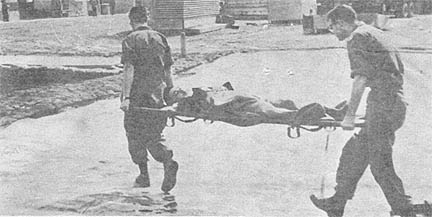 |
Page 6 TROPIC LIGHTNING NEWS June 26, 1967
Cu Chi PX Doubles Sales Area
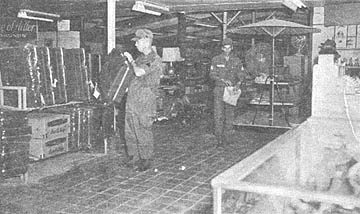 The Cu Chi post exchange has taken on the look of a stateside
department store since the completion of its expansion program.
The Cu Chi post exchange has taken on the look of a stateside
department store since the completion of its expansion program.
The recent addition of 3000 square feet of floor space to the 25th
Inf Div's base camp PX has doubled the retail sales area, according to
exchange officer MAJ William Finnigan of Petersburg, Va.
The Cu Chi exchange is presently fourth in volume sales among PXs
in the Saigon area, and according to Finnigan, the expansion is expected to
increase that volume even more.
He attributed a large new variety of radios, stereos, cameras and
portable refrigerators for the additional dollar sales.
"We still run short of certain popular items," Finnigan
explained, "which is common throughout Vietnam because of the fast build-up of
troops. The Army, Air Force Exchange Service (AFEX) is doing everything
possible to keep these items in stock. A problem of transportation exists
because the movement of war material from Oakland Army Terminal has first
priority." (Photo by SP5 Rodney Bryan)
Ivymen Snag 4 On Large Ambush
DAU TIENG - Sweeping northwest of their base camp on Operation
"Diamond Head," elements of the 3rd Bde, 4th Inf Div, engaged an enemy
patrol on two succeeding days, resulting in one detained and three dead VC.
The first day the 2nd Bn (Mech), 22nd Inf, was sweeping their
assigned sector. At noon the men set their armored personnel carriers near
a trail and set an ambush of opportunity. A short time later four
uniformed Viet Cong were seen walking down the trail.
SP4 Terry Humper of Saginaw, Mich., said, "We had them dead to
rights. But just then one of our mascots, a spotted black dog, smelled
them and started barking."
The VC, about 75 meters away, jumped off the trail and started to
flee, but some fast maneuvering resulted in the capture of one of the enemy.
Blacky, the dog, had in the past, saved members of an American
patrol from ambush, so he got off with a light reprimand.
The next day, Co B, 4th Bn, 23rd Inf, set a 23-man ambush patrol
near the previous nights battalion perimeter.
The battalion had stayed in an open field about one half mile wide
and one mile long. At first light, the APC's maneuvered through the
surrounding tree lines, and thickets. Anyone spying would have thought
that they were conducting the normal search around base camp, prior to moving
out.
But in one of these thickets, the APC's stopped for a minute.
Immediately the patrol, led by 1LT Paul Lockard of Albany, Ga., leaped from
their cramped quarters inside the vehicle and blended in with the jungle growth.
Soft hats and camouflage faces decreased the chances of being spotted.
The "stay behind" ambush patrol had been designed to stop
anyone attempting to secure the laager area for usable material.
About thirty minutes after the "Triple Deuces" had moved, three
NVA troops walked into the field. Their path took them to within 150 yards
of the treeline ambush.
When they passed through the optimum kill zone, the patrol opened
up.
They didn't have a chance. After a short fire fight, the
men came on line and, through fire and maneuver, worked themselves up to the
enemy.
The total for the two day action was one NVA detained, three dead
and four weapons with web gear. There were no US casualties.
At the battalion command post, on the first day, the prisoner had
acted as if his capture was just about the unluckiest thing to have ever
happened to him. He didn't know how lucky he was. He could have
walked that open field the next day.
Check Shots Before R&R
SAIGON (MACV) - Penang health officials have on record 19 cases of
R&R visitors who arrived with outdated Cholera shots since April.
Though officials have been lenient up to now, continued violations are now
causing "grave concern," according to the Embassy.
Cholera immunizations must have been administered at least six days
prior to arrival, in Penang, and may not be more than six months old.
To avoid the possibility of spending five days and nights in
quarantine all personnel are advised to check their own shot records well in
advance when planning R&R. Remember, cholera shots must be
administered at least six days before departure.
Cloth Weaving Cut Short By Loom Find
DUC PHO - The enemy's first mistake was firing at the armored
personnel carriers. Returning the fire, the 2nd Plt, Trp C, 3rd Sqdn, 4th
Cav attached to the 3rd Bde Task Force, 25th Inf Div, instantly killed two Viet
Cong and wounded another.
The VC made a quick retreat into the small hamlet of Ban An.
Chasing the running enemy, CPT Ronald W. Penn, troop commander, directed his men
to search the hamlet.
It was a surprise when the search produced something other than
hiding enemy. Almost all of the mud buildings concealed a textile machine.
Twenty-nine mechanical looms in all.
After receiving the report of the large find, LTC Clinton E.
Granger, commander of the 2nd Bn, 35th Inf, requested a Chinook helicopter
to evacuate the machinery. The looms were taken by the 3rd Brigade Task
Force troops to district headquarters for later distribution to the villagers of
Duc Pho.
Confiscation of the machinery not only will prevent VC in Duc Pho
District from getting new issues of combat uniforms, but also will provide a new
industry for the friendly Duc Pho villagers.
Mess Hall Walls Ablaze with Flags
DAU TIENG - It takes an original idea to decorate a company mess
hall, but Co C, 2nd Bn (Mech), 22nd Inf, has proven themselves equal to the
task. Their walls are ablaze with over 40 flags donated by the various
state legislatures.
SP4 John Conat of Kellog, Idaho, started the ball rolling one day
when he wrote to every state governor and requested a state flag for use by the
company. One week later the replies started.
With the exception of a few states, who do not have the money set
aside to provide flags, every state has answered the request.
As an example, the Governor and Mr. Wallace of Alabama, sent their
greetings, and thanked the men for their contribution in preserving freedom
around the world. They made known their support and the support of the
people of the state of Alabama for the men fighting over here, and sent a three
by five foot silk state flag.
Mech Sweeps Roads Clean
The once treacherous roads between Cu Chi and Bao Trai, southwest
of the 25th Inf Div base camp, are free from Viet Cong mines. The 1st Bn (Mech),
5th Inf "Bobcats" intend to keep it that way.
The battalion is playing a major role in the 2nd Bde Operation
"Kolekole" with "Roadrunner" missions that keep the roads open.
One of the many objectives of the wide-ranging Kolekole is improvement of Hau
Nghia Province road systems. The goal is to make rapid transportation
between major villages a reality.
Heavily armed personnel carriers rumble through high speed runs
down the route day and night. The four-vehicle patrols are irregularly
spaced to discourage ambush.
Mechanical trouble is one of the biggest problems the unit meets.
The high speed runs take its toll in machinery. A complete combat
maintenance section in the forward base camp keeps the roving patrols on the move.
Roadrunner allows massive quantities of supplies and road building
material to travel by direct route to combat troops and construction sites.
The route, once controlled by the Viet Cong, now provides a secure link in the
Allied mission in Hau Nghia Province.
Avn Bn Major Gets Silver Star
MAJ Danny L. Romig, operations officer of Co A, 25th Avn Bn, was
recently awarded the Silver Star by MG John C. F. Tillson III, 25th division
commanding general.
Romig was decorated for his action March 18 while under intense
fire on a mission to extract an element of the 2nd Bn, 27th Inf,
"Wolfhounds."
Romig was the flight leader of eight "Little Bear" choppers and
while picking up a load of men with his ship, he directed the movements of the
other ships.
Page 7 TROPIC LIGHTNING NEWS June 26, 1967
ARVNs, Tomahawks Work on
MEDCAPs
Photos by PFC Bill Wermine
and
SP4 Bob Villanueva
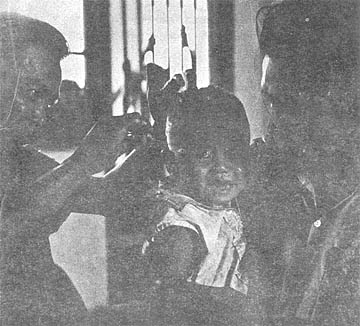 "The first time I have seen a doctor since 1940," said spry old
Mr. Nguyen Van Tri, 86, who was recently treated during a medical civic action
program in a small hamlet near Trang Bang in Trang Bang District, Tay Ninh
Province.
"The first time I have seen a doctor since 1940," said spry old
Mr. Nguyen Van Tri, 86, who was recently treated during a medical civic action
program in a small hamlet near Trang Bang in Trang Bang District, Tay Ninh
Province.
This old man was only one of some 200 people treated during the
MEDCAP which was conducted by four ARVN medics working with a MACV adviser and a
doctor and medics from the 25th Inf Div, 4th Bn, 23rd Inf.
This new joint civic action program will eventually reach all the
hamlets and villages in Trang Bang District. The purpose of the joint
operation is to give treatment to all who need it and at the same time train
ARVN and local forces to the point where they will be able to continue the
program after the Americans leave the area.
Currently the villagers have little or no regular medical treatment
facilities of their own so the MEDCAP are considered a Godsend.
A week after his initial visit Mr. Van Tri was seen at another
MEDCAP apparently trying to make up for lost time.
AW, COME ON DOC - (Above, right) Tearfully a small baby huddles close to
his father as an Army medic administers first aid on a head laceration.
| NIGH ON THIRTY YEARS - Nguyen Van Tri gives a grateful smile as he receives medicine. He had not seen a doctor since 1940. | 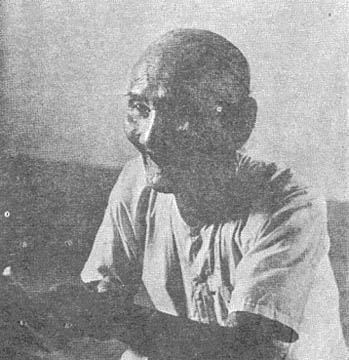 |
Point Can Be Dangerous
DAU TIENG - "I was walking point," said PFC John E.
Maartense,
"and there were some bushes on the left about 15 meters away. VC opened
up on us and I turned just in time to see a Viet Cong point his weapon straight
at me and shoot."
Maartense from Hayward, Calif., was point man for a 15-man patrol
from Co C, 2nd Bn (Mech), 22nd Inf. The Ivymen were probing the jungle.
"The next thing I remembered was being sprawled on the ground
with a ringing in my head," said Maartense.
When Maartense came to his senses and picked up his helmet, there
was a big hole in the middle. The helmet had deflected the bullet so that
it had just creased his head and momentarily knocked him out.
Talking about the patrol back at the company perimeter, patrol
leader Sgt George T. Dahl of Minneapolis, Minn., said, "You have to be quick
over here. This time the enemy was quicker -we were very lucky."
But Maartense was not in so philosophical a mood. "I'm just
happy to be alive."
Just Coolin' It At the Ice Plant
Three men at the Cu Chi base camp just "cool it." That is
their only job, but it is one that is most appreciated by the rest of the
"Tropic Lightning" soldiers.
SP4 Alvin O. Buechel and PFC Richard E. Joronen, both of Co A, 25th
S&T Bn, work with Jack Van Vianen of Pacific Architects and Engineers
(PA&E) manning the two ice plants.
The two plants have an output of 200 blocks of ice every day.
Each block weighs about 300 pounds. The giant ammonia refrigerators have
91 freezer units in each plant and it takes approximately 40 hours for each unit
to freeze one block of ice.
Buechel and Joronen are responsible for issuing the ice to the
different units.
The heyday of ice man is gone in the states and the possibility of
these men making a career of cooling it is slim, but they continue to keep the
men of the 25th Inf Div happy.
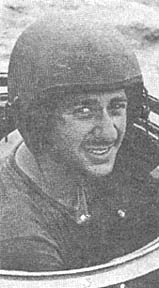 |
What Sort Of Man Reads
TLN? "Driving an APC can be fun but it can also be very dangerous," remarked SP4 David Berti from San Francisco, Calif. Berti, a member of Co C, 1st Bn (Mech), 5th Inf, has been driving the Armored Personnel Carrier for most of his tour in Viet Nam. He has five months remaining. Berti began driving when there was a need for a driver. "I just jumped down in the hole and began driving," explained Berti. "There really isn't much to it." Maintaining his APC is also a requirement for the driver. "It's pretty rough keeping the APC in good shape. Especially in the rugged terrain that the Mech has fought in," said Berti. |
Page 8 TROPIC LIGHTNING NEWS June 26, 1967
Day-Long Fight Nets 76
DUC PHO - "It was Denino's French that helped us find the VC
hideout," said 2LT Michael J. Pulaski as he unfolded the story of the night
and day battle.
Co A, 2nd Bn, 35th Inf, fought what was estimated to be at least a
reinforced company of Viet Cong.
Earlier on the previous day, 1LT John Denino led his platoon on a
sweep through a small hamlet where he interrogated a French-speaking Vietnamese.
The men of the 3rd Bde, 25th Inf Div, learned that a large force of VC were
hiding in the hamlet of Thiet Truong, just a few hundred meters away.
"I set out my listening post at 11:30, and about an hour later we
were hit by about a dozen Cong. We fought them off and then relocated our
landing zone."
It was shortly after one in the morning when they hit again.
This time it was really heavy. The enemy came as close as 20 to 25 meters
and hit with hand grenades, recoilless rifles and automatic weapons.
"For the next three and a half hours," Pulaski continued, "we
blew our Claymore mines, hurled grenades and emptied magazines of ammo to fight
off the enemy.
"With both medics wounded, SP4 Wesley Fox, a forward observer,
took over as medic. It wasn't until four o'clock that morning that the
cavalry arrived with their armored personnel carriers to secure the LZ.
"We really had the VC on the run when the artillery, air strikes
and gun ships swarmed in on his position. Fighting continued throughout
the day and we killed 76 VC and captured 22 weapons.
"All my men did a great job. PFC William Davis, an RTO,
knew that his commo was useless at this point, so he began distributing
ammunition.
"There was SP4 Bobby Day, a rifleman, who took over as machine
gunner under intense enemy fire.
"May 20 will long be remembered by all of us. I'm proud
of the job done by these "Gaotimen," Pulaski concluded.
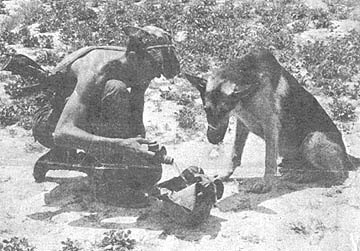 |
BUDDIES SHARE - Taking a break from the heat, PFC Michael Dziekan of Milwaukee, Wis., and his scout dog, Little John, share a drink of water. Dziekan's unit, the 38th Scout Dog PI is working with the 4th Bn, 9th Inf. (Photo by I LT Doug Hudson) |
Ivymen Search At Dawn With Two-Fold Purpose
DAU TIENG - Reacting to intelligence concerning Viet Cong activity
in and around the area of Village number 3 situated in the Ben Cui Rubber
Plantation near Dau Tieng, the Army's 2nd Bn, 12th Inf Command Group, along
with several Vietnamese National Police, conducted a search of the village at
dawn.
While Co B, 2/12th, and an element of the 3rd Bn, 22nd Inf provided
the security cordon, five teams of searchers, with at least two Vietnamese
nationals each, conducted a thorough and detailed search of each individual
"hooch" in an attempt to locate the Viet Cong or indications of their
activity. The search netted one Viet Cong.
Discovering the man's name on a list of Vietnamese with Viet Cong
loyalties, the 3rd Bde, 4th Inf Div. troops with the aid of ARVN troops
immediately commenced interrogation. The questioning confirmed suspicions.
He was, in fact, a Viet Cong. The man is now in the custody of the proper
Vietnamese authorities for additional questioning.
Utilizing a pair of scout dogs in the search party, the teams were
able to easily check underground storage areas and other unattainable places.
Several underground storage areas of considerable size were discovered and
thoroughly searched. When every conceivable "nook and cranny" of the
village had been gone over, the search teams gave way to CPT F. Jay Pepper,
battalion surgeon, and his team of medics who followed with a MEDCAP.
Hundreds of villagers sought medical attention, and a variety of
medicine was administered. With all medical supplies expended, the Ivymen
returned to Dau Tieng.
This particular type of operation accomplishes a two-fold purpose:
it fully demonstrates that the United States means business with the Viet Cong,
and it improves relations with the people by means of a MEDCAP.
'Blue Team' Collides With NVA Bn
DUC PHO - It was the "Blue Team," a platoon of air cavalrymen,
from the 1st Sqdn, 9th Air Cav, who first collided with units of an estimated
NVA battalion.
They had been inserted shortly after noon to check out a suspected
enemy position. The choppers had barely lifted off when they were hit from
all directions.
The "Blues" held their own but were running low on ammo and
being pressed by the NVA when the 1st Plt, Co B, 2nd Bn, 35th Inf, was airlifted
into the battle.
"As we approached the landing zone I could see it was plenty
hot," said 2LT Walter Twyford, the platoon leader. "My chopper was hit
and missed the LZ by 200 meters. We were all able to make it in and link
up with the fighting cavalrymen though."
The bitter fighting continued and an attempt
to overrun the American positions was repelled before more help arrived.
The remainder of Co B and the 2/35th's recon platoon joined the fighting along
with two platoons of armored personnel carriers from the 3rd Sqdn, 4th Cav.
With the APC's and infantrymen battling side-by-side, the NVA
lines were shattered.
"We really had the VC on the run," said Twyford. "Forced from
the trenches he couldn't find enough holes to hide in. As we moved
through the area we started receiving fire from the rear. Many were in
spider holes and we had to sweep back through the area."
Darkness fell and contact continued throughout the night. The
infantrymen of the 3rd Bde, 25th Inf Div, now had a new danger to contend with
as the NVA began firing mortar and recoilless rifle rounds into the perimeter.
"When the mortar rounds began to fall I was too busy to be
scared," said SGT Kenneth J. Hills of the 3/4 Cav. Hills had fired 50-60
magazines of M-16 rounds, a case of M-79 grenades, and 3000 rounds of 50-caliber
machine gun ammo.
Aided by air strikes, artillery and "Spooky," the "Cacti"
and 3/4 Cav routed the NVA. A search of the battlefield the next day
turned up 87 Communists killed by body count and numerous weapons including a
60mm mortar, recoilless rifle and machine gun.
'Golden Dragons' Strike Hard, Fast
Fighting from heavily fortified VC bunkers, SSG George D. Taylor of
Columbia, S.C., and his ambush patrol from Co C of the "Golden Dragons" were
able to ambush a patrol of well armed and disciplined VC.
After allowing the point man to pass, Taylor let the second man
have it with the blast of a claymore mine. Other men on the ambush opened
up with M-16 and M-79 fire which killed the squad leader. Two other VC
were seen to have dropped.
Very quickly the VC broke contact only to return two hours later to
try to reclaim their dead comrades and lost weapons. But they were
unsuccessful because the bunkers that the VC had built were too strong to be
taken. It was ironical that the enemy was defeated by something that he
himself had built. There were no American casualties, and a Russian
assault rifle and a Chinese Communist anti-tank weapon were captured. Two
VC bodies were found. Other VC on the patrol were seen to have been hit
indicating other enemy casualties.
Untouchables Riding High
While the "Untouchables" may yet be touched, there doesn't
appear to be much possibility of them being beaten in the near future.
The "Untouchables" are a softball team composed of clerks,
medics, officers, mechanics, and assorted aficionados representing the Hqs and
Svc Btry, 3rd Bn, 13th Arty. The 25th Inf Div team has issued a standing
challenge to play any team, any time, any place.
In their last game the "Untouchables" topped the officers of
the 2nd Bn, 14th Inf, by a score of 7-0.
The team coach, SP4 Richard Kocsis of Staten Island, N.Y., had this
to say about the game.
"They had everyone from a MAJ to a 2LT playing on that team, but the bat boy
was a PFC."
The winning pitcher was 1SG Roy J. Rapavi of Adena, Ohio.
Rapavi struck out 18 of the 21 batters he faced. He occasionally pitched a
ball over the backstop, just to keep the game interesting. With his
formidable record as a semi-pro and experience on the All-Army team, his
teammates consider him one of the best pitchers in the country.
| FIRE AND DUCK - Shielded by the dense vegetation, a trooper of Co B, 2nd Bn, 35th Inf fires on a VC emplacement. The 3rd Bde, 25th Inf Div unit is working in Quang Ngai Province. (Photo by PFC Paul Halverson) | 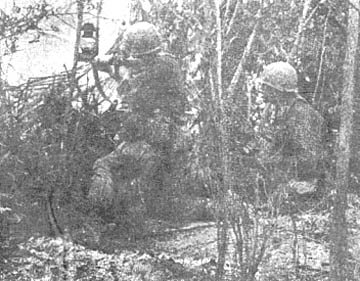 |
Hounds Sweep VC
The aerial assault choppers pounded to the ground and soldiers of
Co B, 1st Bn, 27th Inf
"Wolfhounds," splashed to the muddy earth.
One infantryman was wounded by sniper fire and his buddies covered
the "Dust Off" helicopter with heavy fire as it flew him out.
"I placed the company on line after the ship took off," said
Company Commander CPT Larry Garlock of Cleveland, Ohio, "and we began sweeping
toward the sniper's positions."
After a few hundred yards of the sweep, the company's 1st Plt
engaged the enemy.
The Wolfhound infantrymen moved ahead and discovered one dead Viet
Cong and evidence of others who had fled. The dead man carried five pounds
of documents describing Viet Cong operations along the Oriental River near Duc
Hoa.
One more VC was killed by the company as they spotted him
attempting to swim the winding river.
Thanks to
First Sergeant O.N. Davisson, 25th Aviation Bn. for sharing this issue,
Ron Leonard, 25th Aviation Bn. for locating and mailing the issue,
Kirk Ramsey, 2nd Bn., 14th Inf. for creating this page.
This page last modified 8-12-2004
©2004 25th Infantry Division Association. All rights reserved.